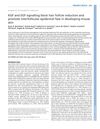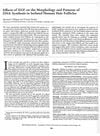TLDR Keloid scars may form due to changes in skin cell characteristics and specific protein signaling.
The study investigated the role of epithelial–mesenchymal transition (EMT) in keloid formation and its underlying mechanisms. Researchers examined EMT-associated markers and TGF-β1/Smad3 signaling in keloid tissues using immunohistochemistry and quantitative real-time PCR. They found a loss of the epithelial marker E-cadherin and a gain of mesenchymal markers FSP1 and vimentin, along with enhanced TGF-β1 expression and Smad3 phosphorylation. Additionally, changes in FGFR2 isoforms and decreased expression of ΔNp63 and TAp63 were observed, which may contribute to abnormal epidermis and appendages in keloids. In vitro, TGF-β1 induced EMT in hair follicle outer root sheath keratinocytes (ORSKs) and normal skin epithelial cells, with ORSKs showing more pronounced EMT changes. The findings suggested that ORSKs might play crucial roles in the EMT process in keloids, providing insights into the molecular mechanisms of keloid pathogenesis.
64 citations
,
January 2013 in “The journal of investigative dermatology/Journal of investigative dermatology” Human stem cells can help form hair follicles in mice.
 82 citations
,
May 2009 in “Development”
82 citations
,
May 2009 in “Development” EGF and KGF signalling prevent hair follicle formation and promote skin cell development in mice.
125 citations
,
February 2007 in “The EMBO Journal” Fgfr2b helps maintain healthy skin and prevent cancer.
142 citations
,
June 2003 in “The journal of investigative dermatology. Symposium proceedings/The Journal of investigative dermatology symposium proceedings” Hair follicle stem cells can generate all hair cell types, skin, and sebaceous glands.
April 2019 in “The journal of investigative dermatology/Journal of investigative dermatology” A specific mutation in the TRPV3 gene causes hair follicle cells to develop improperly, leading to hair loss.
45 citations
,
April 2001 in “The journal of investigative dermatology/Journal of investigative dermatology” Different Myc family proteins are located in various parts of the hair follicle and may affect stem cell behavior.
10 citations
,
October 2000 in “PubMed” E6/E7 oncogenes in hair follicles cause continuous hair growth by skipping the resting phase.
 94 citations
,
February 1994 in “The journal of investigative dermatology/Journal of investigative dermatology”
94 citations
,
February 1994 in “The journal of investigative dermatology/Journal of investigative dermatology” EGF makes hair follicles grow longer but stops hair production.
59 citations
,
August 1981 in “PubMed” Trichilemmal keratinization is a unique process in hair follicles where the outer root sheath turns into keratin without a specific layer.



